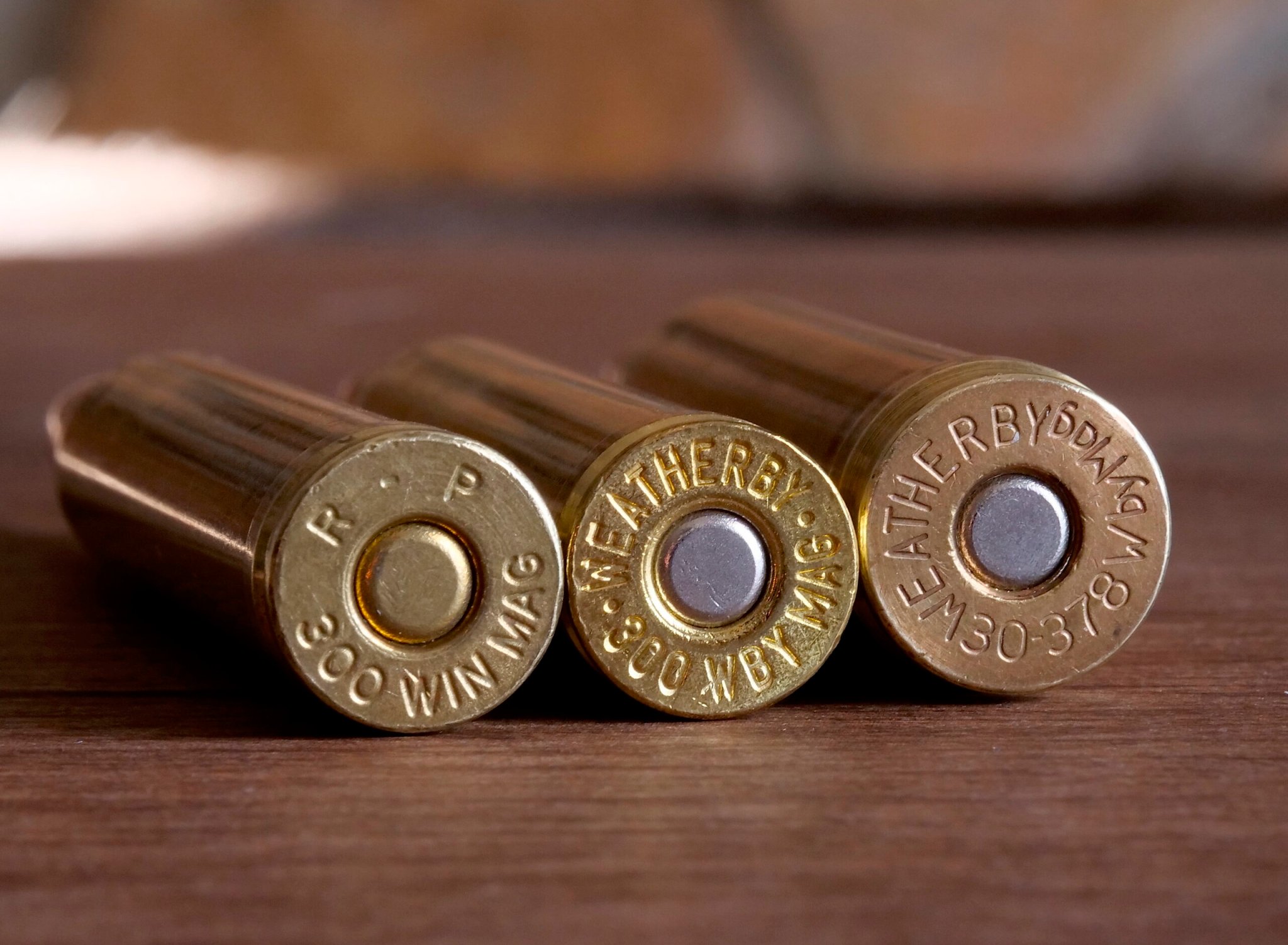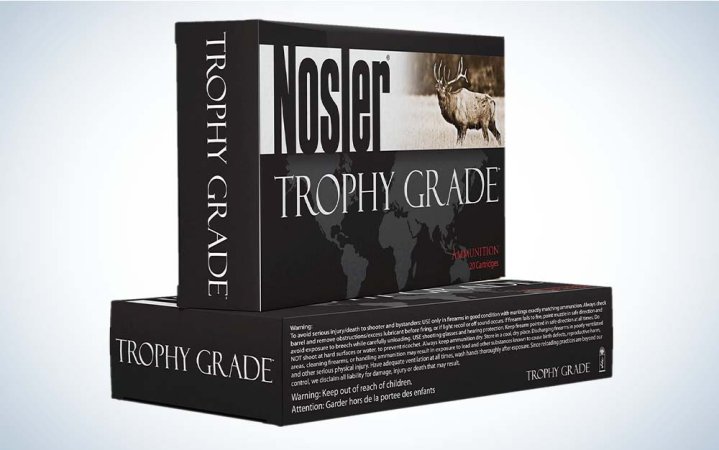We may earn revenue from the products available on this page and participate in affiliate programs. Learn More ›
The .30-378 Weatherby Magnum is the fastest .30-caliber rifle cartridge in the world. It’s about 500 fps (341 mph) faster than a .30/06 Springfield. The 3.6-inch long .30-378 Weatherby Magnum cartridge burns 115 grains of high intensity smokeless nitro powder to drive a massive 220-grain bullet 3,050 fps from a 26-inch barrel. That bullet is cruising along at 2,080 mph and carrying 4,545 foot-pounds of kinetic energy, enough potential energy to lift one-pound of mass 4,545 feet off the ground.
This is not your granddad’s deer cartridge. But it was Adam Weatherby’s grandpa’s military test cartridge. Adam is the current CEO of Weatherby, Inc., a family-owned rifle manufacturing company that claims title to “fastest and most powerful commercial cartridge” for many calibers from 24 to 45. His grandfather, Roy Weatherby, was the creative wildcatter who invented the Weatherby mystique.
The History of Weatherby’s .30-378
The .30-378 emerged in 1959 when Roy reduced the neck diameter of his massive .378 Weatherby Magnum cartridge (think elephants) to grip a .308-inch diameter bullet. Roy was hoping he could answer the U.S. military’s request for a light projectile hitting 6,000 fps. The best Roy could do with powders of the day was slightly more than 5,000 fps.
Wildcatters didn’t need 6,000 fps for the 1,000-yard benchrest shooting they were indulging. They just needed as much muzzle velocity as they could safely and sanely get for delivering long, heavy, high B.C. bullets into tiny clusters. They thought the necked-down .378 Wby. could do the job (it did). In 1987 Earl Chronister parked nine bullets from his custom .30-378 Wby. Mag. into a 3.125-inch circle at 1,000 yards. His tenth shot opened the group to 4.375 inches, still tight enough to stand as the world record.
.30-378 Specifications
A highly capable extreme range target shooting bullet, the .30-378 Weatherby Magnum can kill elk, moose, caribou, brown bears, eland, kudu, sable, and similar size game beyond 300 yards. Mule deer, pronghorn, and sheep can be killed effectively past 400 yards. At .30-378 speeds, 165- to 220-grain bullets deliver at long range what lesser .30-calibers do at mid-range. Just be prepared for oversized recoil, short barrel life, expensive ammo, and a certain amount of notoriety for packing the biggest, fastest, hardest hitting .30-caliber.
- Cartridge: 30-378 Weatherby Magnum
- Released: 1996
- Parent Case: .378 Weatherby Magnum
- Case Length: 2.913 in.
- Rim Diameter: .579 in.
- Belt Diameter: .603 in.
- Head Diameter: .5817 in.
- Body Diameter: .582 in.
- Body Taper: .0207 in.
- Case Water Capacity: 130 grains
- OAL: 3.648 in.
- Rifling Twist: 1:10
- MAP: 63,817 psi
- Typical Bullet Weights: 165 to 230 grains
- Rifles and Ammunition: Weatherby or custom
- Maximum Range: 8,500 yards (4.8 miles)
The Fastest .30-Caliber Bullet Also Comes With Plenty of Recoil

Roy never did legitimize the .30-378, but his son Ed did in 1996. It’s faster than the .300 Win. Mag., .300 Wby. Mag., 30 Nosler, and even the huge .300 RUM. Thanks to modern, slow burning powders, the voluminous .30-378 Wby. case can, it’s been rumored, hit 6,000 fps when fired from extra heavy, extra strong, experimental test barrels and rifles. In real world, sporter-weight rifles Weatherby rates its 220-grain factory loads at 3,040 fps, its 195-grain at 3,225 fps, and its 180-grain at 3,420 fps. These are from 26-inch barrels. Target shooters using 30-inch barrels for a more complete combustion of slow burning powders report gaining about 100 fps more. Such velocities are shown in some respected handloading manuals.
Obviously, speed comes at a price: recoil. In an 8-pound rifle the “light” 180-grain load will hit you with 56 foot-pounds of energy. Stepping up to a 10-pound rifle tames 180-grain recoil to 45 foot-pounds. To put that in perspective, a .308 Winchester in an 8-pound rifle shooting a 180-grain bullet kicks with just under 20 foot-pounds. Therefore many, if not most, serious .30-378 Wby. Mag. shooters plug their ears and use muzzle brakes or suppressors.
Another way to reduce recoil in this big 30 is with lighter bullets. A 165-grain at 3,500 fps bucks 40 foot-pounds in a 10-pound rig. A 150-grain slug (not ideal) at 3,600 fps tames things down to about 39 foot-pounds.
Maximizing the .30-378’s Potential
Some shooters consider it a waste of potential to shoot bullets as light as 180 grains in the big .30-378. Smaller 300s such as the .300 Weatherby Magnum and .300 Winchester Magnum do well enough in this arena. They’ll push 150-grain projectiles within 200 fps of the .30-378’s top speed while burning 30 grains less powder. (No one is accusing the .30-378 Wby. Mag. of excessive efficiency.)
It’s with 200-grain to 250-grain projectiles that the .30-378 reaches its potential and delivers its hardest punches. Couple that mass with sleek, high B.C. shape and you get long range reach and energy that smaller magnums can’t touch. The .300 Win. Mag. might push a 220-grain 2,800 fps. The .30-378 will give it an additional 200- to 300 fps.
Here again recoil rears its ugly head. Pushing that 220-grain slug at 3,100 fps from an 8-pound sporting rifle penalizes you with 62 foot-pounds of recoil.
Zero dead on at 300 yards and peak trajectory creeps just over 4 inches above line-of-sight at 175 yards and doesn’t fall below line-of-sight until 355 yards. The 4,695 foot-pounds of muzzle energy clings to slightly more than 1,500 foot-pounds clear out to 1,000 yards. At that distance, bullet velocity is still some 700 fps above the speed of sound. No worries about wonky bullet flight characteristics in the transonic range with this baby. No wonder extreme range target shooters love it.
Let’s not forget about wind deflection. With this load, a 10 mph right angle wind will nudge that 220-grain bullet just 4 inches at 300 yards; only 12 inches at 500 yards. That makes targets a lot easier to hit in variable winds.
The Drawbacks of Shooting the .30-378

In addition to heavy recoil, there is the issue of compromised bullet performance with the .30-378. As most hunters know, frangible cup/core bullets tend to come apart at high impact velocities. The solution is easy. Just shoot homogenous alloy bullets such as Barnes TTSX or Hammer Hunters. They’ll stand up to the hardest hits inside of 300 yards. But what happens as velocities drop at extended ranges? Here there is potential for limited expansion. But that issue applies to virtually any cartridge spitting these harder, controlled expansion bullets. Every bullet has its expansion characteristics compromised by more or less velocity. Shoot a softer, more expandable bullet such as a bonded lead core and it’s liable to shed 50 percent or more of its weight during high velocity impacts like the 2,664 fps our 220-grain will still be hammering at 300 yards.
The challenge, then, is matching .30-378 Weatherby Magnum to the game, the bullet, and the anticipated range at impact. But then isn’t that the challenge with any cartridge? Run a .30-30 Winchester and you surely don’t need to worry about bullet performance at 400 yards. Shoot a .30/06 instead and you still risk excessive expansion at 150 yards, insufficient at 500 yards. Truly there is no easy answer short of limiting your game shots to the distances and impact velocities at which your chosen bullet is designed to perform optimally. The .30-378 Wby. Mag. just gives you more options than any other 30-caliber.
Read Next: Master Shot Placement on Western Big Game
There is one additional .30-378 challenge you don’t face with a .30/06 Springfield or .308 Winchester — barrel burnout. Barrels “burn” (or more precisely crack and erode) at the throat where the flame from the burning powder is hottest. Expanding and contracting of the steel leads to the rifling lands crumbling like an old concrete sidewalk. Many .30-378s erode throats enough to ruin accuracy in as few as 600 shots. This can be minimized to a degree by avoiding multiple shots through an already hot barrel. Cleaning, polishing, and conditioning can help by eliminating or filling any tiny holes or cracks that would otherwise enlarge with additional shots.

